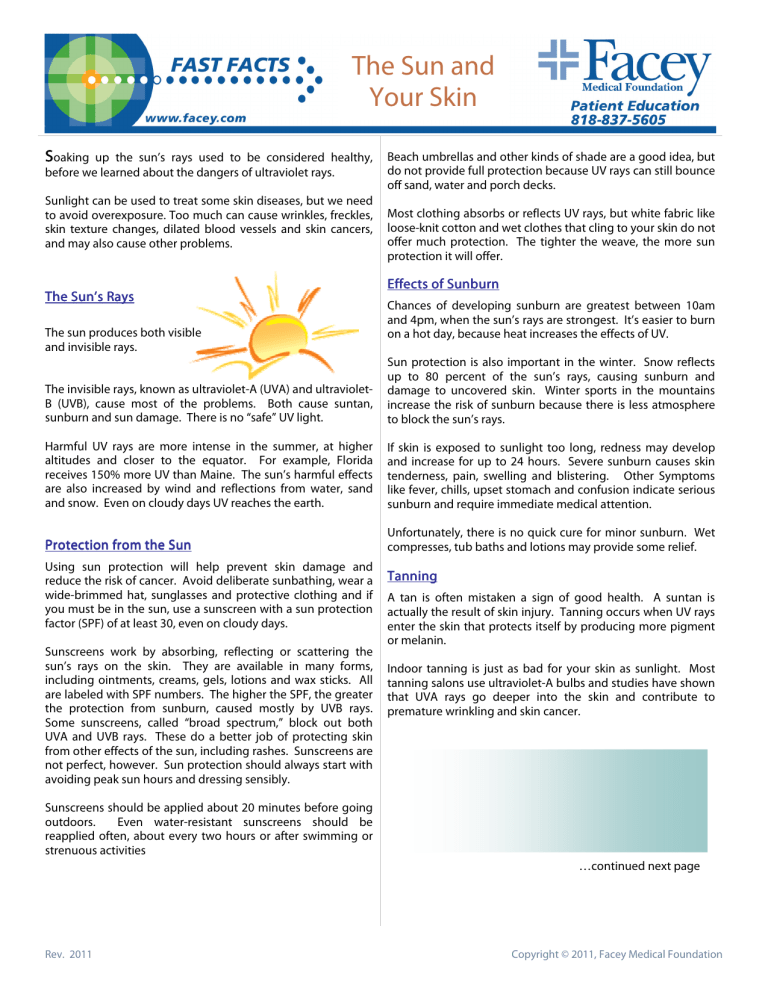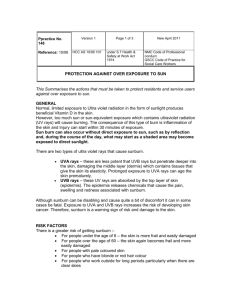Sun and Your Skin - Facey Medical Group

The Sun and
Allergies
S oaking up the sun’s rays used to be considered healthy, before we learned about the dangers of ultraviolet rays.
Sunlight can be used to treat some skin diseases, but we need to avoid overexposure. Too much can cause wrinkles, freckles, skin texture changes, dilated blood vessels and skin cancers, and may also cause other problems.
The Sun’s Rays
The sun produces both visible and invisible rays.
The invisible rays, known as ultraviolet-A (UVA) and ultraviolet-
B (UVB), cause most of the problems. Both cause suntan, sunburn and sun damage. There is no “safe” UV light.
Harmful UV rays are more intense in the summer, at higher altitudes and closer to the equator. For example, Florida receives 150% more UV than Maine. The sun’s harmful effects are also increased by wind and reflections from water, sand and snow. Even on cloudy days UV reaches the earth.
Protection from the Sun
Using sun protection will help prevent skin damage and reduce the risk of cancer. Avoid deliberate sunbathing, wear a wide-brimmed hat, sunglasses and protective clothing and if you must be in the sun, use a sunscreen with a sun protection factor (SPF) of at least 30, even on cloudy days.
Sunscreens work by absorbing, reflecting or scattering the sun’s rays on the skin. They are available in many forms, including ointments, creams, gels, lotions and wax sticks. All are labeled with SPF numbers. The higher the SPF, the greater the protection from sunburn, caused mostly by UVB rays.
Some sunscreens, called “broad spectrum,” block out both
UVA and UVB rays. These do a better job of protecting skin from other effects of the sun, including rashes. Sunscreens are not perfect, however. Sun protection should always start with avoiding peak sun hours and dressing sensibly.
Sunscreens should be applied about 20 minutes before going outdoors. Even water-resistant sunscreens should be reapplied often, about every two hours or after swimming or strenuous activities
Beach umbrellas and other kinds of shade are a good idea, but do not provide full protection because UV rays can still bounce off sand, water and porch decks.
Most clothing absorbs or reflects UV rays, but white fabric like loose-knit cotton and wet clothes that cling to your skin do not offer much protection. The tighter the weave, the more sun protection it will offer.
Chances of developing sunburn are greatest between 10am and 4pm, when the sun’s rays are strongest. It’s easier to burn on a hot day, because heat increases the effects of UV.
Sun protection is also important in the winter. Snow reflects up to 80 percent of the sun’s rays, causing sunburn and damage to uncovered skin. Winter sports in the mountains increase the risk of sunburn because there is less atmosphere to block the sun’s rays.
If skin is exposed to sunlight too long, redness may develop and increase for up to 24 hours. Severe sunburn causes skin tenderness, pain, swelling and blistering. Other Symptoms like fever, chills, upset stomach and confusion indicate serious sunburn and require immediate medical attention.
Unfortunately, there is no quick cure for minor sunburn. Wet compresses, tub baths and lotions may provide some relief.
Tanning
A tan is often mistaken a sign of good health. A suntan is actually the result of skin injury. Tanning occurs when UV rays enter the skin that protects itself by producing more pigment or melanin.
Indoor tanning is just as bad for your skin as sunlight. Most tanning salons use ultraviolet-A bulbs and studies have shown that UVA rays go deeper into the skin and contribute to premature wrinkling and skin cancer.
…continued next page
Rev. 2011 Copyright © 2011, Facey Medical Foundation
Rev. 2011
The Sun and
Your Skin
Allergic Reactions
Some people develop allergic reactions to the sun. These reactions may show up after only a short time in the sun.
Bumps, hives, blister, or red blotches are the most common symptoms of a sun allergy. Sometimes these reactions are due to cosmetics, perfumes, plants, topical medications, or sun preparations. Certain drugs, including birth control pills, and blood pressure, arthritis and depression medications can cause a skin rash with sun exposure.
People who work outdoors or sun bathe without sun protection can develop tough, leathery skin, making them look older than they are. The sun can also cause large freckles called “age spots” and scaly growths (actinic keratoses) that may develop into skin cancer. These skin changes are caused by years of sun exposure.
Protecting children from the sun is especially important, since most of our lifetime exposure occurs before the age of 20.
More than 90 percent of all skin cancers occur on sun-exposed skin. The face, neck, ears, forearms and hands are the most common places it appears.
The three most common types of skin cancer are basal cell carcinoma, squamous cell carcinoma and melanoma.
Usually develops on the face, ears, lips and around the mouth of fair skinned individuals. It can start as a red patch or shiny bump that is pink, red or white. It may be crusty or have an open sore that does not heal or heals only temporarily. This type of cancer can be cured easily if treated early.
Usually appears as a scaly patch or raised, warty growth. It also has a high cure rate when found and treated early. In rare cases, if not treated, it can be deadly.
The most dangerous form of skin cancer. It usually looks like a dark brown or black mole-like patch with irregular edges.
Sometimes it is multicolored with shades of red, blue, or white.
This type of skin cancer can occur anywhere on the body and when found early, can be cured. If ignored, it spreads throughout the body and can be fatal.
Some diseases can be made worse by the sun, including cold such as lupus erythematosus. UV rays also can cause cataracts, a gradual clouding on the lens of the eye. sores, chickenpox and a number of less common disorders
1.
Use a broad-spectrum sunscreen with an SPF of at least 30 on all exposed skin, including the lips, even on cloudy days.
2.
Reapply sunscreen frequently.
3.
Wear a broad-brimmed hat and sunglasses.
4.
Sit in the shade whenever possible.
5.
Wear protective, tightly-woven clothing.
6.
Plan outdoor activities early or late in the day to avoid peak sunlight hours between 10am and
4pm.
Everyone should be able to enjoy sunny days. By using a little common sense, you can safely work and play outdoors without worrying too much about skin cancer or wrinkles.
For information about classes th at Facey offers, call toll free 866 837----5605.
Copyright © 2011, Facey Medical Foundation

